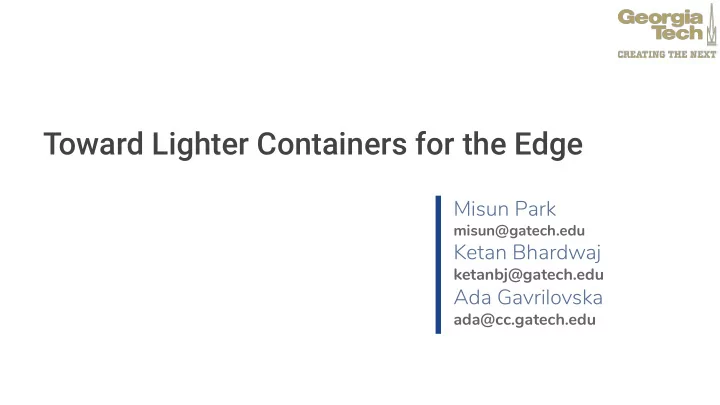

Toward Lighter Containers for the Edge Misun Park misun@gatech.edu Ketan Bhardwaj ketanbj@gatech.edu Ada Gavrilovska ada@cc.gatech.edu
Migrate Things from Cloud to the Edge K. Bilal, O. Khalid, A. Erbad and S. U. Khan, “Potentials, trends, and prospects in edge technologies: Fog, cloudlet, mobile edge, and micro data centers”, Computer Networks , vol 130, pp 94–120, 1 2018, doi: 10.1016/j.comnet.2017.10.002. 2
Challenges in Edge Computing Cloud native applications can be adopted directly to the edge? Limited Image Slow Resource Bloat Startup 3
Limited Resources 4
Image Size Bloat ● Containerized applications with bloated size Due to heavy/complex runtimes ○ ○ Hardware acceleration supports With GPU support like CUDA runtime, the number becomes far worse 5
Slow Launch Time 2000 msec 40 msec Docker run Python language runtime bootup Workload execution starts → Runc run Import TensorFlow 200 msec 1700 msec 6
Alternative approach: Checkpoint/Restore MB Resource- Not solving Nimble to demanding image bloat start? Checkpointing requires additional memory by nature. ● Figure: Comparison of maximum memory usage of containers with TensorFlow application, using between checkpoint restore and cold boot, respectively. 7 1) Image Size a) Bootup Time b) Checkpoint/Restore based approach solves the lengthened bootup latency? 2) Resource Pressure a) However, the answer to Q2 incurs heavy resource pressure -- C/R incurs a high memory cost.
Alternative approach: Single long-running monolithic container + Limit resource requirement to a single runtime + Remove need for on-demand launch time Application - Exposes new programming and deployment APIs Runtime - Does not leverage existing container-based infrastructure 8
Addressing the Gap ● Seeking opportunity to satisfy the edge requirements while retaining the benefits from containerization ● Our answer is: shared backend Application Runtime 9
Addressing the Gap: Shared Runtime Backend ● Shared backend is a long running service process, warms up thick runtimes in advance and allows them to be shared among multiple instances ● Applications do not need to include, or launch heavy runtime itself, but just borrow them Application Runtime 10
Addressing the Gap: Shared Runtime Backend + Lightweight Application Containers ● Benefits from containerization retained with smaller image size … A1 A2 AN Runtime 11
Addressing the Gap: Shared Runtime Backend + Lightweight Application Containers ● Resource pressure reduced thanks to not instantiating multiple runtimes for each applications … A1 A2 AN Runtime 12
Pocket ● a new lightweight system to support edge computing ● splits containerized applications into two parts: application container and a A service container bloat-causing runtime service container + retains benefits of container technologies achieves lower resource pressure, higher + responsiveness, and better scalability Application containers 13
Execution Model / Programming Model Application Application Application Container Container Container Workload Isolation response request Pocket Interface High Performance IPC Service Container Python Tensorflow PyTorch Concurrency and Dynamic Resource Scaling in Runtime Devices File System 14
Evaluation 15
Experimental Setup https://github.com/zzh8829/yolov3-tf2 16
Pocket achieves higher resource efficiency ● Pocket demands less resource when # instances are equivalent. ○ Pocket application does not include Tensorflow in it, but monolithic application package must possess Tensorflow as its part ○ One Tensorflow-service process vs. N Tensorflow-service process 17
Pocket improves application performance ● Pocket outperforms monolithic with regard to mean execution time ○ Pocket benefits from shared backend, and also shared model Mean time to launch 1 & 10 concurrent instances # Instances Pocket Monolithic 1 10.75 10.64 5 9.944 11.288 10 4.442 12.335 20 3.3245 12.663 (second) 18
Pocket allows for lightweight application containers ● Lightweight communication mechanism is necessary gRPC and its dependency take time to import ○ Mean time to launch 1 & 10 concurrent instances # Instances Pocket-ssh Pocket-rpc Monolithic 1 58.69 2793.50 2575.63 10 63.55 6627.37 5800.86 (millisecond) 19
Summary of Contributions Pocket approach to application stack for the edge Path Open Problems Forward Questions Image bloat Concurrency, isolation, Compact containers with lightweight and Slow startup for the edge with Resource pressure high-performance IPC shared backend runtimes 20
Recommend
More recommend